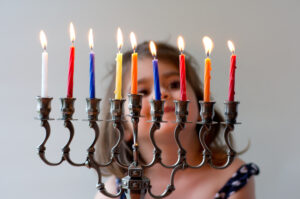
Hanukkah—Its Origins, Traditions and Significance
The Stories and Customs Behind the Jewish Festival of Lights
From Sunday, December 18 through Monday, December 26, 2022, members of the Jewish faith will celebrate Hanukkah, the eight-day Jewish “Festival of Lights.” What is Hanukkah? What are its origins? How is Hanukkah customarily celebrated?
What Is Hanukkah?
Derived from the Hebrew word meaning “to dedicate,” Hanukkah remembers the rededication of the Second Temple in Jerusalem in the 2nd century B.C.E. Though not one of the major religious holidays within the Jewish faith, it is one of the more commonly known, most likely because it typically falls around the same time as the Christmas holiday. Hanukkah, however, is scheduled according to the Hebrew calendar, falling on the 25th day of Kislev, which may be anywhere from late November to late December on the Gregorian calendar.
What Does Hanukkah Commemorate?
Around 200 B.C.E., when Judea was a part of the Seleucid Empire, Jewish subjects there were allowed to live and worship “according to their ancestral customs,” and did so at the Second Temple. In 175 BCE, however, Judea was invaded, the Second Temple was looted and shut down, and Judaism was banned. Antiochus IV, the King of Judea, erected an altar to Zeus, banned circumcision and had pigs sacrificed on the altar of the Second Temple. Those actions led, in 167 BCE, to a successful revolt by Jewish subjects, who liberated and rededicated the Second Temple. Hanukkah pays homage to the retaking and rededication of the Second Temple.
Why Does Hanukkah Last for Eight Days?
As a part of the rededication of the Second Temple, a new altar was commissioned, and new holy vessels were built. However, at the time of the rededication, the celebrants could only find enough olive oil to keep the menorah’s candles burning for one day. Nonetheless, they lit the menorah, which burned continuously for eight days, giving the liberators time to secure a fresh supply of oil. This eight-day period is commonly referred to as the “Hanukkah miracle.”
What Are the Common Traditions of Hanukkah?
Perhaps the most well-known of Hanukkah traditions is the lighting of the menorah. On each night throughout Hanukkah, the menorah is lit, with an additional candle lit each night. According to tradition, the candles should be lit at least a half an hour before dark. Candles may not, however, be lit on Shabbat, so the Friday night candles must be lit before the sun sets. When the Hanukkah candles are lit, a blessing is said both for the lighting of the candle and for the miracle of Hanukkah.
An additional light/candle is lit each night, known as a shammash, translated from the Hebrew as “attendant” or “sexton.” The shammash ensures that the menorah candles will be used only for reflecting on the Hanukkah miracle, and will not be used for other purposes, such as illumination in a dark space.
